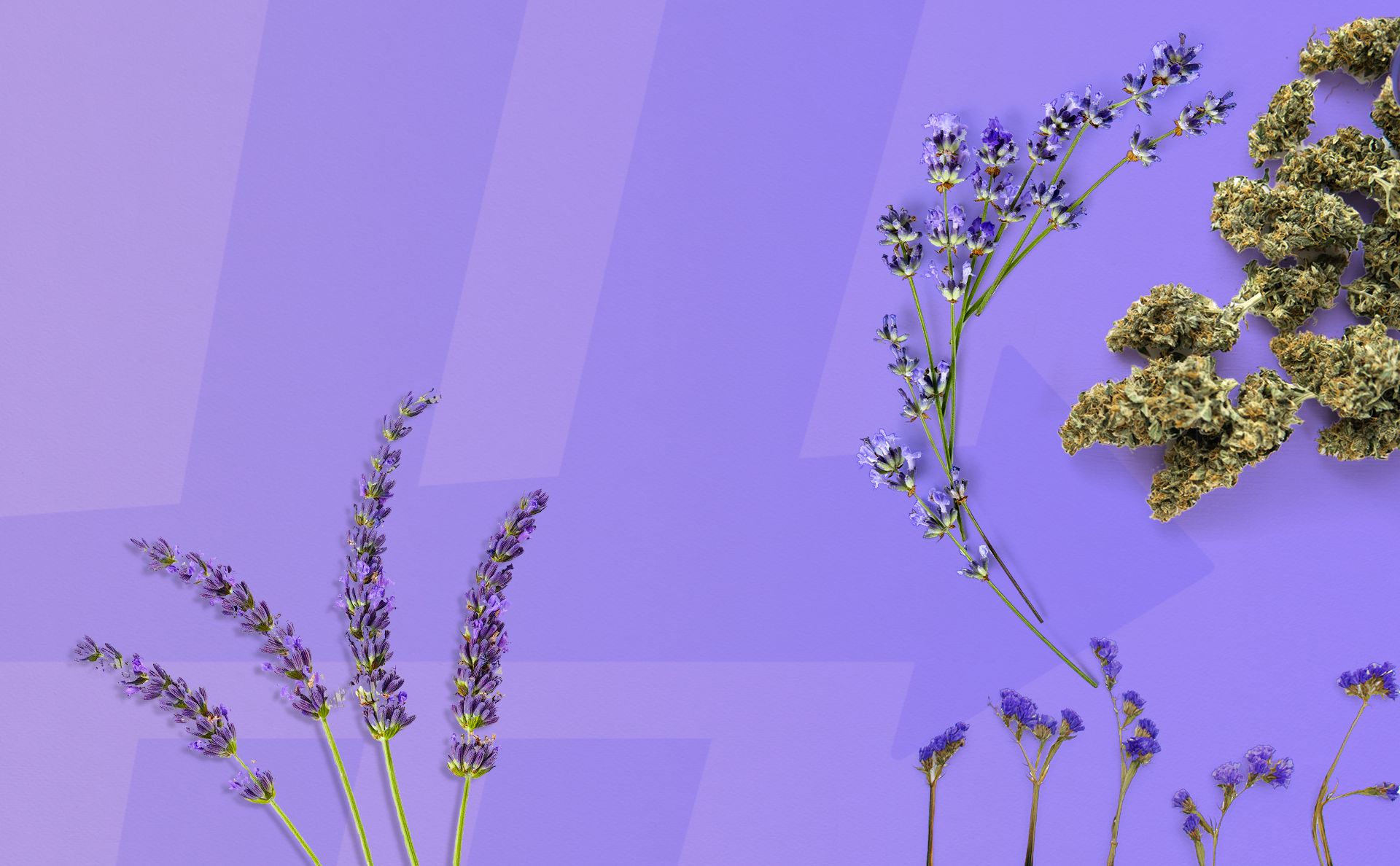Linalool
What is linalool? How does it make you feel, and what are its benefits? This chapter answers these questions and more.

In this chapter of our terpene guide, we cover linalool. This floral, sweet terpene is reminiscent of lavender and has hints of earthy and woody flavors. Which plants contain linalool? Are there any benefits of this terpene? Read on for more.
What is Linalool?
Pronounced ‘Lynn-Uh-Lawl”, linalool is an organic terpene alcohol that occurs naturally in many parts of the world. Linalool is one of the most common terpenes found in our natural world. This versatile terpene can be found in over 200 plants.
Linalool is most often used in food flavorings like lemon, orange, cardamom, cocoa, and much more. It’s also common in skincare and cosmetic products, and the terpene profile is typically extracted from the lavender plant. Other plants and spices that contain linalool include basil, thyme, jasmine, and rosewood.
Linalool is also widely commercially available in essential oils of lavender, orange blossom, bergamot, rose, and lily. These are already popular and well-known for relieving stress and anxiety through aromatherapy in many settings like meditation, exercise, work, or just at home.
Terpene Flavor and Aroma Profile: Linalool
Linalool has a mostly floral and slightly sweet aroma, like clean laundry, which is pleasant to the nostrils. Linalool can be found in some of the highest concentrations in lavender plants. Depending on the plant, linalool can also give off a taste and smell that is a bit spicy, especially when combined with caryophyllene.

Linalool has a very pleasant scent, which is why it can be found in a multitude of flowers and spice plants worldwide. In fact, Linalool is so common in our natural world, that even those of us who don’t consume cannabis might ingest up to 2 grams a year just by eating common foods.
Cultivars with the Terpene Linalool
Linalool is found in abundance in our natural world, and is one of the eight most common terpenes in cannabis. You know you’re perhaps enjoying the terpene profile of linalool when your cannabis tastes floral and sweet with a hint of spice. Cultivars that contain linalool include:
Linalool can be found as a third terpene in many purple cultivars, although this doesn’t always mean that purple varieties will taste or smell floral. Linalool is often overpowered by the first and second terpene in a cultivar’s profile, so if you are in search of varieties with a significant linalool content, you might find it to be a bit of a difficult search.
Does Linalool Get You High?
Until recently, terpenes were considered non-psychoactive. However, recent evidence suggests a dozen common terpenes like linalool can be 10-50% as strong as THC – with linalool estimated around 18%. This means terpenes don’t get you as high as THC will, and linalool could amplify its psychoactive effects, too.
Linalool can also offer non-intoxicating and pleasant benefits to consumers. These include pain-relieving, antidepressant, relaxing, and sleep-inducing benefits.
How Does Linalool Make You Feel?
One reason why linalool is found in hundreds of plants in our natural world is thanks to this terpene’s pollinator-attracting properties. Linalool serves as a lure for bees and moths, while repelling other insects and bacteria. It confers communication abilities and protection for many plants, and can also possibly be beneficial for human consumption.
When exposed to this interesting terpene, mice in laboratory situations have shown a decrease in anxiety and depressive behaviors. These studies in mice don’t always translate to usefulness in humans, but promising, small clinical research shows OTC linalool-rich Silexan™ is as effective for anxiety as the prescription antidepressant paroxetine.
In addition to its anti-microbial and sedative properties, the terpene linalool can possibly be useful for pain and stress relief and act as an anti-anxiety agent. The linalool in lavender aromatherapy even decreased the need for opioids in a small post-surgical setting.
Studies show that linalool may offer therapeutic benefits for patients with Alzheimer’s and Parkinson’s disease due to its neuroprotective and calming effects, reducing agitation, anxiety, and depressive symptoms. Its potent antioxidant effects on the brain also show promise in animal models of stroke, ischemia, inflammatory pain, bacterial infection, and cognitive function.
Does Linalool Make You Sleepy?
Some of linalool’s pain-relieving properties may be ascribed to its activation of adenosine, glutamate, opioid, and ion-channel receptors, according to research. These receptors are generally inhibitory and help stop pain signals. Increased activation of adenosine receptors by linalool may be a reason why linalool has sedative and pain-relieving benefits.
Because of its impact on the serotonin and GABA receptors, linalool is often helpful for consumers seeking relief from insomnia, anxiety, and depression. Additionally, linalool is found in peanut leaves, which is why it has been used in herbal healing methods for years, thanks to its sedative effects and anti-microbial properties.
What We Learned: Linalool
Linalool is one of the most complex and interesting terpenes. It is also one of the most soothing, thanks to its abundance of lavender-like aromas. Here’s what we learned in this chapter:
- Found in over 200 plants, linalool is one of the most abundant terpenes in the natural world.
- Linalool is often used in skincare and cosmetic products, and the terpene profile is typically extracted from the lavender plant.
- Other plants and spices that contain linalool include basil, thyme, rosemary, jasmine, and rosewood.
- Linalool can be found in some of the highest concentrations in lavender plants.
- Linalool has a very pleasant, clean, floral, and sweet scent, which is why it can be found in a multitude of flowers and spice plants worldwide. It allows plants to communicate and attract important pollinators, while keeping away pests and bacteria.
- Cultivars that contain linalool include Trainwreck, Do-Si-Dos, Zkittles, Chemdawg, Scooby Snacks, and more.
- Some of linalool’s pain-relieving properties may potentially be attributed to its elevated adenosine levels, an inhibitory brain chemical. Increased activity of many non-cannabinoid receptors like adenosine, serotonin, glutamate, opioid, and GABA may be a reason why linalool has sedative and pain-relieving benefits.
- Studies show that Linalool acts as a natural anti-microbial and sedative, and may help with depression and anxiety.
Linalool is one of the many terpenes found in cannabis, and yet another one that we are constantly learning more about. We are only scratching the surface when it comes to all the things we need to know about the invaluable plant medicine that is cannabis. We will hopefully see more benefits of linalool uncovered as more unbiased studies are conducted on cannabis medicine.
Answer the question below if you're ready for the next chapter in our Terpenes guide.
Citations
- Benavides, A. (2022, July 21). Linalool—Terpenes and Cannabinoid Research. Cannakeys.https://cannakeys.com/linalool-terpene-research/
- Kim, J. T., Ren, C. J., Fielding, G. A., Pitti, A., Kasumi, T., Wajda, M., Lebovits, A., & Bekker, A. (2007). Treatment with lavender aromatherapy in the post-anesthesia care unit reduces opioid requirements of morbidly obese patients undergoing laparoscohttps://doi.org/10.1007/s11695-007-9170-7
- Liktor-Busa, E., Keresztes, A., LaVigne, J., Streicher, J. M., & Largent-Milnes, T. M. (2021). Analgesic Potential of Terpenes Derived from Cannabis sativa. Pharmacological Reviews, 73(4), 1269–1297.https://doi.org/10.1124/pharmrev.120.000046
- Raz, N., Eyal, A. M., Zeitouni, D. B., Hen-Shoval, D., Davidson, E. M., Danieli, A., Tauber, M., & Ben-Chaim, Y. (2023). Selected cannabis terpenes synergize with THC to produce increased CB1 receptor activation. Biochemical Pharmacology, 212, 115548.https://doi.org/10.1016/j.bcp.2023.115548
- Sommano, S. R., Chittasupho, C., Ruksiriwanich, W., & Jantrawut, P. (2020). The Cannabis Terpenes. Molecules, 25(24), 5792.https://doi.org/10.3390/molecules25245792
- Wei, C., Liu, H., Cao, X., Zhang, M., Li, X., Chen, K., & Zhang, B. (2021). Synthesis of flavour-related linalool is regulated by PpbHLH1 and associated with changes in DNA methylation during peach fruit ripening. Plant Biotechnology Journal, 19(10), 2082https://doi.org/10.1111/pbi.13638
- Weston-Green, K., Clunas, H., & Jimenez Naranjo, C. (2021). A Review of the Potential Use of Pinene and Linalool as Terpene-Based Medicines for Brain Health: Discovering Novel Therapeutics in the Flavours and Fragrances of Cannabis. Frontiers in Psychiatrhttps://doi.org/10.3389/fpsyt.2021.583211
- Zhang, L., Su, Q.-F., Wang, L.-S., Lv, M.-W., Hou, Y.-X., & Li, S.-S. (2023). Linalool: A ubiquitous floral volatile mediating the communication between plants and insects. Journal of Systematics and Evolution, 61(3), 538–549.https://doi.org/10.1111/jse.12930
Test your knowledge, track your progress and earn your badge.
Which plant contains the highest concentration of linalool?
Commonly known as the floral terpene, linalool is a popular stress-relieving terpene often extracted from the lavender plant and is also found in many pleasant-smelling flowers.

Dr. Abraham Benavides
Dr. Abraham Benavides is an internationally-recognized cannabis research expert, experienced medical advisor, and full-tuition merit scholar of the George Washington University School of Medicine and Health Sciences. Dr. Abe enjoys helping patients as a writer, educator, and cannabis health coach at the GW Center for Integrative Medicine.